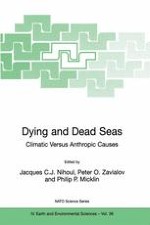
2004 | OriginalPaper | Buchkapitel
What do we know about dead, dying and endangered lakes and seas?
verfasst von : Andrey G. Kostianoy, Peter O. Zavialov, Sergey A. Lebedev
Erschienen in: Dying and Dead Seas Climatic Versus Anthropic Causes
Verlag: Springer Netherlands
Enthalten in: Professional Book Archive
Aktivieren Sie unsere intelligente Suche, um passende Fachinhalte oder Patente zu finden.
Wählen Sie Textabschnitte aus um mit Künstlicher Intelligenz passenden Patente zu finden. powered by
Markieren Sie Textabschnitte, um KI-gestützt weitere passende Inhalte zu finden. powered by
Shallowing and degradation of some freshwater and salt lakes and inland seas are among major environmental problems at the beginning of the century. 96.5% of the planet’s water is salty water in oceans and seas. Nearly 70% of the world’s fresh water is frozen in the Antarctic and Greenland ice sheets, glaciers, and permanent snow cover and ice. About 30% of all fresh water is groundwater. Lakes and rivers contain only 0.25% of all fresh water. All over the globe, water is being diverted for industrial, agricultural and household uses. The United Nations announced that about 3 billion people would face severe water shortages by 2025 if the present consumption rates persist. More than five million people die every year from water-related diseases such as cholera and dysentery. Significant desiccation, salinization and water quality degradation have taken place in many inland water bodies over the past century. The most striking examples are: (1) the Lobnor Lake in China which completely dried up by 1972; (2) the Dead Sea whose level has dropped by 14 m since 1977 and whose present salinity is about 340 g/1; (3) the Aral Sea whose level has dropped by about 23 m and the salinity increased eightfold since 1960; and (4) Lake Chad which has shrunk to about a twentieth of its size of 1963.